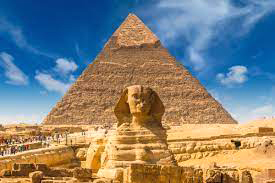The Mysteries of the Pyramids of Egypt
Mysteries of the Pyramids
The Mysteries of the Pyramids of Egypt
The Pyramids of Egypt are some of the most iconic structures in the world and have been the subject of fascination and mystery for thousands of years. There are more than 100 pyramids in Egypt, but the most famous are the three pyramids of Giza, which were built around 4,500 years ago and are considered some of the greatest architectural achievements of ancient times.
One of the biggest mysteries of the pyramids is how they were built. The pyramids are massive structures, with the Great Pyramid of Giza being the largest, standing at 147 meters tall. It is estimated that more than 2 million stone blocks, each weighing an average of 2.5 tons, were used to build the pyramids. How the ancient Egyptians were able to cut, transport, and assemble such large blocks of stone with such precision is a mystery that has puzzled experts for centuries. Some theories suggest that ramps and sledges were used to move the blocks, while others believe that cranes or pulleys were used to lift the stones into place.
Another mystery of the pyramids is their purpose. Although most people associate the pyramids with Pharaohs and the ancient Egyptian afterlife, the exact purpose of the pyramids is still not known. Some believe that they were simply tombs for the pharaohs and their queens, while others think that they were religious or astronomical structures used for ceremonies and observing the stars. There is evidence to support both theories, but the true purpose of the pyramids remains a mystery.
The construction of the pyramids was also a mystery in terms of the workforce. The pyramids are estimated to have been built by tens of thousands of workers, but how they were able to coordinate such a large number of people is unknown. There is also a mystery surrounding the workers themselves, as there is no record of where they came from or how they were paid. Some believe that the workers were slaves, while others think that they were skilled laborers who were paid for their work.
Another mystery of the pyramids is their precision and symmetry. The pyramids are incredibly precise structures, with walls that are almost perfectly straight and corners that are almost perfectly square. How the ancient Egyptians were able to achieve such accuracy is unknown, as they did not have access to modern surveying equipment or mathematical tools. Some believe that the pyramids were built using a combination of astronomy, geometry, and simple trial and error, while others think that they had access to advanced mathematical knowledge that has since been lost.
Finally, the mystery of the interior of the pyramids is another unsolved mystery. The interiors of the pyramids are complex structures, with intricate passages, chambers, and shafts that lead to the tomb of the pharaoh. The purpose of these passages and chambers is unknown, as is the reason for the strange angle and direction of the shafts. Some believe that the passages and chambers were used to symbolize the journey of the pharaoh to the afterlife, while others think that they served a practical purpose, such as allowing air to circulate and preserving the mummies of the pharaohs.
In conclusion, the Pyramids of Egypt are a testament to the ingenuity and architectural prowess of the ancient Egyptians, but they remain shrouded in mystery. From the purpose and construction of the pyramids to the workforce and the precision of their design, the pyramids continue to fascinate and puzzle experts and laypeople alike. Despite centuries of study and investigation, many of the mysteries of the pyramids remain unsolved, making them one of the greatest enigmas of the ancient world. 0 0 0. Mysteries of the Pyramids
The Mysteries of the Pyramids of Egypt
You May Like:
N.B. The article ‘The Mysteries of the Pyramids of Egypt’ originally belongs to the book ‘Essays on Science And Technology‘ by Menonim Menonimus.
Books of Composition by M. Menonimus:
- Advertisement Writing
- Amplification Writing
- Note Making
- Paragraph Writing
- Notice Writing
- Passage Comprehension
- The Art of Poster Writing
- The Art of Letter Writing
- Report Writing
- Story Writing
- Substance Writing
- School Essays Part-I
- School Essays Part-II
- School English Grammar Part-I
- School English Grammar Part-II..
Related Search:
- Piramyd Mysteries
- The architecture of the Pyramids of Egypt
- Saturn-NASA Solar System Exploration
- History of Saturn
- Pyramids of Giza
- The Egyptian Pyramid











